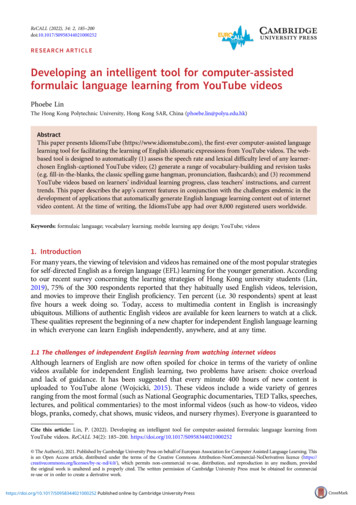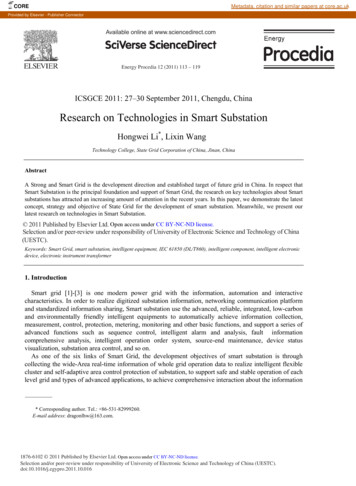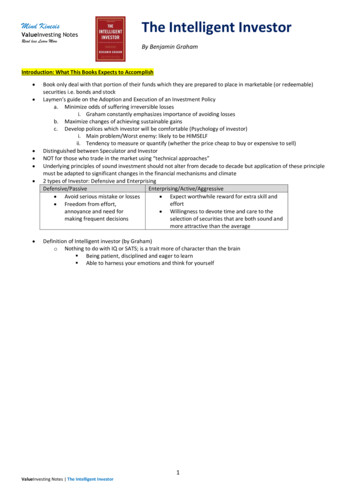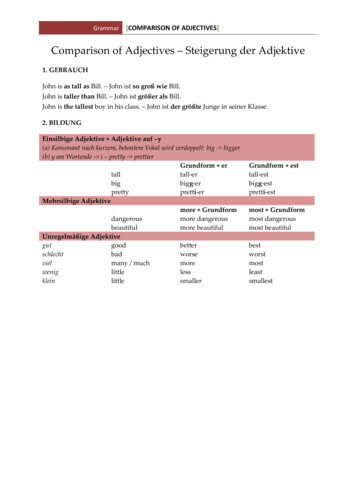
Transcription
ReCALL (2022), 34: 2, 185–200doi:10.1017/S0958344021000252RESEARCH ARTICLEDeveloping an intelligent tool for computer-assistedformulaic language learning from YouTube videosPhoebe LinThe Hong Kong Polytechnic University, Hong Kong SAR, China (phoebe.lin@polyu.edu.hk)AbstractThis paper presents IdiomsTube (https://www.idiomstube.com), the first-ever computer-assisted languagelearning tool for facilitating the learning of English idiomatic expressions from YouTube videos. The webbased tool is designed to automatically (1) assess the speech rate and lexical difficulty level of any learnerchosen English-captioned YouTube video; (2) generate a range of vocabulary-building and revision tasks(e.g. fill-in-the-blanks, the classic spelling game hangman, pronunciation, flashcards); and (3) recommendYouTube videos based on learners’ individual learning progress, class teachers’ instructions, and currenttrends. This paper describes the app’s current features in conjunction with the challenges endemic in thedevelopment of applications that automatically generate English language learning content out of internetvideo content. At the time of writing, the IdiomsTube app had over 8,000 registered users worldwide.Keywords: formulaic language; vocabulary learning; mobile learning app design; YouTube; videos1. IntroductionFor many years, the viewing of television and videos has remained one of the most popular strategiesfor self-directed English as a foreign language (EFL) learning for the younger generation. Accordingto our recent survey concerning the learning strategies of Hong Kong university students (Lin,2019), 75% of the 300 respondents reported that they habitually used English videos, television,and movies to improve their English proficiency. Ten percent (i.e. 30 respondents) spent at leastfive hours a week doing so. Today, access to multimedia content in English is increasinglyubiquitous. Millions of authentic English videos are available for keen learners to watch at a click.These qualities represent the beginning of a new chapter for independent English language learningin which everyone can learn English independently, anywhere, and at any time.1.1 The challenges of independent English learning from watching internet videosAlthough learners of English are now often spoiled for choice in terms of the variety of onlinevideos available for independent English learning, two problems have arisen: choice overloadand lack of guidance. It has been suggested that every minute 400 hours of new content isuploaded to YouTube alone (Wojcicki, 2015). These videos include a wide variety of genresranging from the most formal (such as National Geographic documentaries, TED Talks, speeches,lectures, and political commentaries) to the most informal videos (such as how-to videos, videoblogs, pranks, comedy, chat shows, music videos, and nursery rhymes). Everyone is guaranteed toCite this article: Lin, P. (2022). Developing an intelligent tool for computer-assisted formulaic language learning fromYouTube videos. ReCALL 34(2): 185–200. https://doi.org/10.1017/S0958344021000252 The Author(s), 2021. Published by Cambridge University Press on behalf of European Association for Computer Assisted Language Learning. Thisis an Open Access article, distributed under the terms of the Creative Commons Attribution-NonCommercial-NoDerivatives licence /), which permits non-commercial re-use, distribution, and reproduction in any medium, providedthe original work is unaltered and is properly cited. The written permission of Cambridge University Press must be obtained for commercialre-use or in order to create a derivative work.https://doi.org/10.1017/S0958344021000252 Published online by Cambridge University Press
186Phoebe Linfind some English video input that interests them, but the sheer volume of choice available canhave a negative impact on learning (see Iyengar & Lepper, 2000). As Vohs et al. (2008) suggest,choosing from among so many alternatives is effortful and may deplete cognitive resources. Thisexplains why their subjects showed a deterioration of self-control, stamina, persistence in the faceof failure (i.e. they gave up more easily), as well as actual performance in tasks when offered severalchoices. In education, teachers are also keenly aware of the need to avoid choice overload in orderto ensure the effectiveness of learning. It has been advised thatManaging choice overload is critical for both student satisfaction and performance. Whenstudents choose from options tailored to their abilities and prior knowledge levels, theyare both more satisfied and learn more effectively than when presented with too many ortoo few choices (Volz, Higdon & Lidwell, 2019: 11).Unfortunately, this fundamental need to manage choice overload is often overlooked in discussions surrounding how best to support independent EFL learning through the use of online videos(see also Lin, 2014; Lin & Siyanova-Chanturia, 2014).The second, and perhaps more pressing, concern is the lack of guidance. Given the rate atwhich new video content is uploaded online, it is impossible for teachers to design customisedactivities to facilitate learning from every online video, or to provide at least a list of noteworthyEnglish usage features in it. Learners are often left to engage in freestyle self-reflection on whatthey have learned. For those who have weak independent language learning skills, this uncertaintysurrounding the key knowledge to be gained from each video is unhelpful.1.2 The aims of this paperTo address these two problems, the IdiomsTube app was designed to facilitate the noticing andindependent learning of formulaic expressions (FEs) in any user-chosen English-captionedYouTube video. Informed by the latest research on second language vocabulary acquisition,the app offers key features known to enhance the effectiveness of FE learning in context.These features include automatic identification of noteworthy FEs in the English subtitles ofany videos posted on YouTube, automatic assessment of the difficulty of the vocabulary, theautomatic generation of a multimodal concordance of system-identified vocabulary items, theautomatic generation of contextual usage, form recall and verbal repetition tasks, gamificationfeatures, a learning progress tracking system for class teachers, and so on.This paper describes the rationale, the design features, and the research underlying the developmentof the IdiomsTube app. It also discusses the theoretical and technical challenges facing the development of tools for computer-assisted learning of English from video streams. Since launching theapp for open access use by individuals and schools in November 2018, over 8,000 learners and teachersworldwide have started using it. For empirical evidence supporting the effectiveness of the IdiomsTubeapp for facilitating FE learning, see Lin (under review).2. Formulaic expressions: The key to native-like proficiency in English as a foreignlanguageFE is an umbrella term subsuming all types of lexicalised word combinations including idioms(e.g. raining cats and dogs, spill the beans), speech formulae (e.g. easy does it, let’s get on top ofit), proverbs (e.g. an apple a day keeps the doctor away), sayings (e.g. better safe than sorry, timeand tide wait for no man), similes (e.g. as white as snow, sleep like a log), binomials (e.g. safe andsound, hustle and bustle, kith and kin), collocations (e.g. ask-question, staggering-figures, primeminister), and so on. Although FEs are very common in daily communication, they arechallenging for even advanced-level English learners (Spöttl & McCarthy, 2004).https://doi.org/10.1017/S0958344021000252 Published online by Cambridge University Press
ReCALL187Two studies in particular that provide strong empirical evidence for the difficulty of learningFEs are Webb, Newton and Chang (2013) and Pellicer-Sánchez (2017). Both studies examinedincidental learning of FEs. In these studies, EFL learners were exposed repeatedly to a smallset of collocates embedded within short stories and then tested on their knowledge of the items.In Webb et al.’s (2013) study, learners recalled only 12% of the target 18 verb-noun collocates inthe immediate post-test even though they saw the items five times. In Pellicer-Sánchez’s study(2017), the learning outcome was not better, with learners recalling only 7% of the six noveladjective-noun collocations in the one-week-delayed post-test despite having seen the items fourtimes. These poor learning outcomes from incidental FE learning have prompted English languageteaching (ELT) experts and researchers to explore ways of speeding up and enhancing FE learningthrough more explicit FE instruction.2.1 Computer-assisted learning of formulaic expressionsAcross the world, researchers are competing to solve the problems confronting second languageFE acquisition. The main solution that has emerged involves enhancing the input by highlightingor glossing FEs (Bishop, 2004; Peters, 2012; Szudarski & Conklin, 2014; Wible, 2008) becauselearners’ failure to notice the presence of FEs seems to be the source of the problem (Lin,2012; Littlemore, Chen, Koester & Barnden, 2011; Martinez & Murphy, 2011).Bishop (2004) and Wible (2008), in particular, pioneered the use of computer technology toincrease the salience of FEs in electronic written texts. Bishop (2004) created a program thatunderlined, highlighted, and glossed FEs, whereas Wible (2008) developed a web browserplug-in that detected and listed the collocations present in any webpage that the learner visited.The development of these computer tools was motivated by the growing body of evidencesupporting the effectiveness of input enhancement for FE acquisition (Bishop, 2004; Peters,2012; Szudarski & Conklin, 2014; Wible, 2008). In fact, Peters’ (2012) experiment indicated thatinput enhancement could lead to statistically significant gains in FE knowledge. Direct instruction,on the other hand, showed no significant impact.While Bishop (2004) and Wible (2008) facilitated new possibilities for using computertechnology to promote L2 English FE learning, these first-generation tools remain limited. First,they cannot handle spoken language or videos, despite initial evidence showing that spoken inputmay be more conducive to FE learning than written input (see Lin, 2021, for experimental evidenceand Lin, 2012, for a discussion of the theoretical basis for this argument). Second, the tools stop atthe point of input enhancement and lack components for the consolidation of FE knowledge. AsSzudarski and Conklin (2014) show, consolidation is vital for the exposure to the input to produce alasting gain in FE knowledge. In their study, significant knowledge gain was recorded immediatelyafter the exposure to highlighted FEs, but had disappeared in the six-week-delayed post-test. Third,the tools stop at the point of learning the form and semantics of the FEs but contribute little to thelearning of deeper levels of FE knowledge, such as their pragmatics or phonology.3. IdiomsTube: A mobile and personalised web-based app for FE learning throughYouTube videosIdiomsTube (https://www.idiomstube.com) is the first computer-assisted language learning toolfor facilitating the independent learning of FEs from YouTube videos (see Figure 1). It is unique inthe sense that it (1) enables FE learning from extensive exposure to online videos, and (2) seeks tooffer a comprehensive and effective FE learning experience with a range of personalised andadaptive FE learning tasks powered by an individualised FE learning profile database that storeslearners’ video preferences and learning histories.IdiomsTube consists of three key components: automatic assessment of video difficulty,automatic tasks generation, and video recommendations, in addition to a range of featureshttps://doi.org/10.1017/S0958344021000252 Published online by Cambridge University Press
188Phoebe LinFigure 1. The homepage of IdiomsTube with the video search box and recommended videosdesigned to provide a comprehensive and enjoyable FE learning experience such as gamification,bookmarks, revision flashcards, idiom-of-the-day posts, IdiomsTube Facebook and Instagrampages, and an IdiomsTube Teacher’s interface.This section gives an overview of these features. The rationale behind and the technical detailsconcerning these features will be discussed in section 4.3.1 Automatic tasks generationThis component automatically generates FE learning tasks for all English-captioned videosavailable for online streaming on YouTube.1 Learners can find videos based on topics of personalinterest (e.g. documentary, TED Talks, baking). The system then retrieves the 50 most recentrelated videos in real time from the YouTube website using the YouTube official API (seeFigure 1). Once the learner has chosen a video to watch, the system automatically detects thepresence of noteworthy FEs in the captions and generates three types of learning tasks basedaround the items, namely pre-learning, knowledge consolidation, and progress management tasks.These tasks direct learners’ attention to the FEs in the videos and progressively consolidate theirmemory of their form and usage (see Figure 2).3.1.1 Pre-learning tasksThe pre-learning tasks consist of two parts (i.e. the glossary and the dictionary lookup) that aim todraw learners’ attention to the presence and meanings of noteworthy vocabulary items present in1Due to uncertainties about the accuracy of YouTube auto-caption, the generation of learning tasks has been disabled forvideos without user-uploaded English captions in the current version of 52 Published online by Cambridge University Press
ReCALLChoose avideoView theglossaryLook updefini ckscores andprogressFigure 2. The workflow of learning tasks that learners need to complete on IdiomsTubeFigure 3. The video page showing a glossary of noteworthy FEs and hyperlinks to corresponding dictionary entries. Items inthe glossary may be bookmarked for later reference. See also estimates of a video’s difficulty and speech rate ratings abovethe video windoweach video (see Figure 3) and enhance learners’ comprehension of the video content. TheIdiomsTube app is able to recognise 53,635 FEs present in YouTube videos. For every FE, thesystem generates a glossary with clickable hyperlinks to reputable and free online dictionaries(e.g. http://www.oxforddictionaries.com/, https://idioms.thefreedictionary.com/).3.1.2 Consolidation tasksThe consolidation tasks consist of two parts (i.e. the exercises and the selected scene replay) thataim to raise learners’ awareness of the ways the FEs have been used in context in the selected videoand enhance their memory of their phonological and orthographic forms. Three types of exercisesare available: fill-in-the-blanks, spelling, and pronunciation.The fill-in-the-blanks exercise requires learners to complete the video’s original lines bychoosing the correct FEs (see Figure 4; note that Figures 4 to 19 are presented in the supplementary material). In this way, learners’ attention can be drawn to the FEs’ use in context.Should learners have difficulties recalling the correct FEs, they may click the Hint button to replaythe exact scene in which each FE occurs.The spelling task takes the form of the classic word game hangman, played in context, with theFEs as the answers learners must recall (see Figure 5). To excel at the game, learners need toaccurately recall the orthographic form of each FE.https://doi.org/10.1017/S0958344021000252 Published online by Cambridge University Press
190Phoebe LinThe pronunciation exercise requires learners to read aloud and record FEs using IdiomsTube’sbuilt-in audio recorder.2 The FEs appear embedded within the video’s original lines and arepresented one by one. As shown in Figure 6, the Hint button is available to replay the scenein which each FE was used. These replays are a useful means of drawing learners’ attention tothe pragmatics of each FE, including its level of formality, its context of use, and, most importantly, the tone of voice appropriate for its pronunciation (see Lin, 2012, 2013, 2018a, 2018b,for an in-depth discussion of the special prosody of FEs).3.1.3 Revision tasksThe revision tasks enable learners to easily monitor their FE learning progress (see Figures 7 and8), to review their vocabulary diaries (see Figure 9) and revision flashcards (see Figure 10), and toaddress their needs and/or weaknesses. In the vocabulary diary, learners can see the full list of FEsencountered in previously watched videos and their mean score for each item, as well as itemspreviously bookmarked. They then have several options. They can view the concordance linesshowing the FEs used in all previously watched videos and click the hyperlinks to replay the corresponding scenes or conduct revision using the flashcards. A stack of 10 flashcards will be autopopulated and shown every time a learner logs in. Each flashcard reminds the learner of an FElearned from a previously watched video. The flip side of the card shows an example of how the FEwas used in context in the video (see Figure 10).All of the aforementioned tasks are delivered through a simple and user-friendly interface (seeFigure 1) following a specified workflow (see Figure 2). As the tool runs on the internet as a webbased application, it is compatible with any operating system and can be opened using the webbrowser on a personal computer or on any internet-enabled mobile devices. This ubiquity ofaccess means that learners can enjoy self-directed FE learning using the app while on short breaksor on the go.3.2 Video recommendationThe issue of video choice overload is tackled by the video recommendation component that assistsEFL learners in finding comprehensible input among the tens of millions of English-captionedYouTube videos available. The component automatically assesses the difficulty level of allretrieved videos (see Figure 1) and instantly recommends videos based on EFL learners’ progresswithin IdiomsTube (see Figure 11). In addition to recommendations based on language difficulty,the system also incorporates recommendations by the IdiomsTube community. Videos watchedby other users (i.e. the trending videos) and videos recommended by teachers who useIdiomsTube with their classes (see Figure 12) also appear on each learner’s personalisedfront page.3.3 Additional special featuresTo offer a comprehensive and enjoyable FE learning experience, IdiomsTube also provides a rangeof special enhancement features such as gamification, idiom-of-the-day posts, the IdiomsTubeTeacher’s interface and IdiomsTube Facebook and Instagram pages.Gamification is defined as “the application of videogame techniques such as rules, rewards, andlevels to real-world situations : : : in order to maximize the loyalty and motivation of participants”(Chandler & Munday, 2020). In IdiomsTube, learners earn experience points (with exp as theshort form) for each video watched and each task attempted and are promoted to a higher levelwhen a certain points threshold has been reached. As shown in Figure 13, learners are rewarded2The audio recordings are processed using Python module SpeechRecognition 3.8.1 (https://pypi.org/project/SpeechRecognition/) which connects to speech recognition engine Wit.ai 021000252 Published online by Cambridge University Press
ReCALL191with badges and prestigious titles (Level 1 Idiom Newbie Level 2 Idiom Rookie Level 3 IdiomTrainee Level 4 Idiom Specialist Level 5 Master of Idioms). The nicknames of top scorersalso appear in the IdiomsTube’s Halls of Honour (the IdiomsTube World Leaderboard and theIdiomsTube School Leaderboard).To connect the communities of IdiomsTube users, Facebook and Instagram pages have been setup. IdiomsTube users may also interact with each other, as well as the research team, through publicposts or private messages. At the time of writing, the two pages had 1,884 followers/subscribers. Inorder to maintain activity on the pages, a picture or video post introducing an English FE is releasedevery day. The same posts also pop up at every log in to the IdiomsTube website.To enable school teachers and learners to incorporate IdiomsTube into their regular weekly ordaily English language homework, the IdiomsTube Teacher’s interface was created. This interfaceallows teachers to conduct multiple functions, including the automatic compilation of reports onthe learning progress of every student and class, analysis of the vocabulary difficulty, speech rateand FE distribution of any English-captioned YouTube video, the growth of a personal repositoryof YouTube videos for use as teaching materials, and the ability to promote recommended,captioned YouTube videos to selected classes. (For further elaboration and demonstration ofthe Teacher’s interface’s functions, please see Figures 14–19 and https://tinyurl.com/yy6gzflb.)4. The research underpinning the development of the IdiomsTube appThe design of the Idioms Tube app and its functions has been informed and supported by varioustheories and findings concerning effective FE learning. This section provides an account of thelinks between the methodological decisions made in the app development process and researchinto vocabulary acquisition.4.1 The FE list for automatic extraction of English FEsTo automatically generate the learning tasks, the system first detects and extracts English FEspresent in each YouTube video. This is done using a pattern-matching approach, which operatesby searching for matching patterns in the caption based on a pre-defined dictionary of FEtemplates (see also Rayson, 2003). The advantage of this approach is that FEs can be identifiedeven when they appear in variant forms. For example, variant forms of the FE template put * togood use (with * representing 0–3 words) can be extracted by the system, such as in:the space has been put to good useput it to good useput the money to good useAt the time of writing, the IdiomsTube FE dictionary contained 53,635 templates, which haveall been lemmatised (using Python’s NLTK package). These entries range from two to 23 words inlength, with a mean length of 3.94 words. They were collected by the author over the years fromprint and online sources, including dictionaries of idioms, proverbs, sayings, slang, and famousquotes. The idiomatic status of these items in the IdiomsTube dictionary can be verified by the factthat they also appear in reputable dictionaries.33For generating the pre-learning tasks, each FE needs to be hyperlinked to online dictionaries. These dictionaries includehttps://idioms.thefreedictionary.com (71.44%), https://www.cambridge.org (7.33%), https://www.collinsdictionary.com(7.15%), https://www.merriam-webster.com (5.68%), https://www.macmillandictionary.com (4.84%), en.wiktionary.org(1.35%), https://www.phrases.org.uk (1.06%), en.oxforddictionaries.com, https://www.brainyquote.com, https://www.thefreedictionary.com, https://www.yourdictionary.com, https://www.vocabulary.com, and https://www.urbandictionary.com ( 1%).https://doi.org/10.1017/S0958344021000252 Published online by Cambridge University Press
192Phoebe Lin4.2 The design of the learning activitiesLearning a foreign language through listening alone is difficult. Due to the limited capacity ofshort-term memory and time pressure, the human brain is hardwired to prioritise the decodingof meaning from auditory input rather than remembering words verbatim. To facilitate verbatimmemory of the FEs in the YouTube videos, IdiomsTube learning tasks (see section 3.1) repeatedlyengage learners with the form, meaning, and usage of the FEs before, during, and after viewing.4.2.1 The design of the pre-learning tasksThe pre-learning tasks, which include the glossary and the dictionary lookup, aim to (1) givelearners a clearer idea about the particular vocabulary focus of the video; (2) facilitate the learners’noticing of the FEs (see Schmidt, 1990, for a discussion of the noticing hypothesis, which suggeststhat noticing is an essential starting point for acquisition); and (3) gloss the vocabulary items.There is substantial empirical evidence for the facilitative effect of glossing, glossary and dictionarylookup on incidental vocabulary learning (Hulstijn, Hollander & Greidanus, 1996; Webb, 2010).When attention to and engagement with noteworthy vocabulary is enhanced through providing aglossary and highlighting in bold, learners are more likely to remember the vocabulary than incases where no glossing is provided. Input enhancement may be provided in various formats,although the most common format is to highlight the vocabulary in bold in the original writtentext and to provide a glossary with simple definitions in the first or second language in the margins(Ko, 2012; Yanguas, 2009). As IdiomsTube is open to English learners from all first languagebackgrounds, glossing is provided in this most common format in English as a second language.4.2.2 The design of the consolidation tasksThe consolidation tasks include three types of exercises: fill-in-the-blanks, speaking, and spelling.4This is in addition to the selected scene replay, which can be repeated on demand by clicking theHint button. They were designed to engage learners with different aspects of FE knowledge. Thespeaking and spelling exercises facilitate learners’ recall of the phonological and orthographicforms respectively through production. The fill-in-the-blanks task, on the other hand, consolidateslearners’ recognition of the meaning of the FEs as they are used in context.This task design of these consolidation tasks was guided by the involvement load hypothesis(Laufer & Hulstijn, 2001), which suggests that involvement in vocabulary learning is made upof three parts: need, search, and evaluation. To earn experience points for the fill-in-the-blankexercise, learners must remember the content of the video and correctly recall the FE thatcompletes each original utterance. This represents the need component in Laufer andHulstijn’s (2001) framework. The process of choosing the right answer among the multiplechoices and the re-watching of selected scenes if they are uncertain illustrates search. After fillingin an FE, learners need to reread the completed utterance to determine whether the FE fits and if itis the best choice. This illustrates evaluation. When learners successfully complete all six questionsin each exercise, they get immediate feedback in terms of scores and the correct answers so thatimprovements can be made.The design of these consolidation tasks was also informed by previous research that examinedthe relationship between FE exercise format and learning outcomes. For example, the decision toschedule the three exercises after the video playback was informed by the finding that greater gainsin FE knowledge can be generated by scheduling the exercises after rather than before the exposure(Strong & Boers, 2019). Furthermore, the decision to provide a list of intact FEs (e.g. make a wish)as the multiple choices in the fill-in-the-blank exercise was informed by Boers, Dang and Strong’s4See Szudarski and Conklin (2014) and Durrant and Schmitt (2010) for the importance of consolidation in FE learning, andBoers (2020) for a review of FE consolidation exercise designs.https://doi.org/10.1017/S0958344021000252 Published online by Cambridge University Press
ReCALL193(2017) finding that this practice is less likely to confuse learners than if learners are required tochoose just the appropriate verb, for instance, to complete an FE (e.g. a wish) embeddedwithin a sentence.Of the three tasks, the fill-in-the-blanks appears to be the most popular among currentIdiomsTube users, who consider the multiple-choice fill-in-the-blanks format suitably challenging(Lin, under review). Although the speaking task and the spelling task are slightly less popular, theyare important in terms of providing a variety of tasks through which learners may engage withdifferent aspects of FE knowledge, including their phonological form, orthographic form, andcomposition. According to research in psycholinguistics on the role of the phonological loopin vocabulary learning (Baddeley, Gathercole & Papagno, 1998; see also Lin, 2021), engaginglearners with the phonological form is particularly important for facilitating their memory ofnew vocabulary items. Some empirical studies found that learners who read new vocabulary aloudor silently in their heads seemed to remember the items more effectively than their counterpartswho encountered the same vocabulary but were forbidden from reading the items aloud or silently(Baddeley et al., 1998).4.2.3 The design of the revision tasksThe revision tasks include the personal bookmarks, exercise history, video history, and revisionflashcards. As second language vocabulary studies have shown, repeated and sustained exposureto new vocabulary is important because the process of vocabulary acquisition is incremental (seeSchmitt, 2010, for further discussion). Learners need to encounter a new item eight to 20 times toremember and learn the item (Pigada & Schmitt, 2006; Rott, 1999; Waring & Takaki, 2003). OnIdiomsTube, these repeated encounters accumulate through participation in the pre-learning andconsolidation tasks, in addition to the viewing of personal learning and video diaries as part of thelearning progress management routine. When learners view their progress and exercise history,they can see which items and questions they have answered (in)correctly and replay selectedscenes in which the items are used. This allows them to recall their memory of the form and usage.The revision flashcards are yet anothe
the tools stop at the point of learning the form and semantics of the FEs but contribute little to the learning of deeper levels of FE knowledge, such as their pragmatics or phonology. 3. IdiomsTube: A mobile and personalised web-based app for FE learning through . Figure 1). Once the learner has chosen a video to watch, the system .











